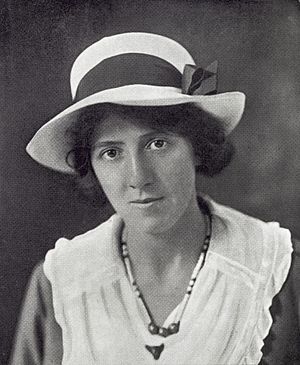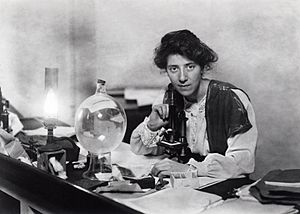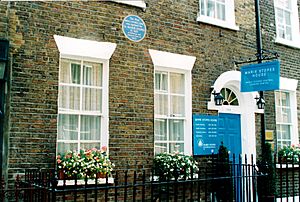Marie Stopes facts for kids
Quick facts for kids
Marie Stopes
|
|
|---|---|

Stopes in 1918
|
|
| Born |
Marie Charlotte Carmichael Stopes
15 October 1880 Edinburgh, Scotland
|
| Died | 2 October 1958 (aged 77) Dorking, Surrey, England
|
| Education |
|
| Spouse(s) | |
| Children | Harry Stopes-Roe |
| Scientific career | |
| Fields | Palaeobotany |
| Institutions | University of Manchester |
Marie Charlotte Carmichael Stopes (born October 15, 1880 – died October 2, 1958) was a British writer and scientist. She was a palaeobotanist, which means she studied ancient plants from fossils. Marie Stopes also worked to improve women's rights.
She made important discoveries about fossil plants and how to classify coal. She was the first female professor at the University of Manchester. With her second husband, Humphrey Verdon Roe, Stopes opened the first free clinic in Britain. Here, married women could get advice on family health.
In 1925, this clinic, called the Mothers' Clinic, moved to Central London. It is still there today. Marie Stopes worked hard to raise money and opened more clinics across Britain. She opened clinics in Leeds (1934), Aberdeen (1934), Belfast (1936), Cardiff (1937), and Swansea (1943).
Contents
Early Life and Education
Marie Stopes was born in Edinburgh, Scotland. Her father, Henry Stopes, was an engineer and also studied ancient life forms. Her mother, Charlotte Carmichael Stopes, was a scholar who studied Shakespeare and fought for women's rights.
When Marie was very young, her family moved to London. Both her parents were part of the British Science Association. This meant Marie grew up around science and met many famous scientists. She was first taught at home. Later, she went to St. George's School for Girls in Edinburgh and then to the North London Collegiate School.
University Studies and Discoveries
In her 20s and 30s, Marie Stopes focused on her science career. She went to the University of London in 1900. She studied botany (plants) and geology (rocks and Earth). She earned her first degree, a Bachelor of Science (B.Sc.), in just two years.
After her father died in 1902, her family faced money problems. Her professor, Dr. Francis Wall Oliver, hired her as his research assistant. This job sparked her deep interest in paleobotany.
Dr. Oliver and Stopes made a big discovery. They found that some ancient "ferns" actually had seeds. These were called "seed ferns" or pteridosperms. This discovery was important because it showed a link between ferns and conifers. Marie Stopes worked with top experts in paleobotany. She then won a special scholarship from University College London.
Advanced Degrees and Teaching
Marie Stopes earned a Doctor of Science (D.Sc.) degree from University College London. She was the youngest person in Britain to achieve this. In 1903, she published a study about plants from the recently dried-up Ebbsfleet River.
She later studied living cycads (a type of plant) at the University of Munich in Germany. She used this research for her doctoral paper, which she wrote in German. In 1904, she received her PhD in botany.
Also in 1904, Marie Stopes became one of the first women to join the Linnean Society of London, a famous group for natural scientists. She also taught students and gave lectures on paleobotany at University College, London, until 1920.
Scientific Research and Contributions
From 1904 to 1910, Marie Stopes worked as a lecturer in paleobotany at the Victoria University of Manchester. This made her the first female academic (professor or lecturer) at that university.
While at Manchester, she studied coal and fossilized plants found in coal. She also researched a collection of Glossopteris, which are ancient seed ferns from the Permian period.
Global Plant Discoveries
In 1907, Stopes spent 18 months in Japan at the University of Tokyo. She explored coal mines on Hokkaidō to find fossilized plants. She discovered many important fossils, including ancient flowering plants from the Cretaceous period. She wrote about these finds in a science journal in 1909. She also wrote a diary about her time in Japan, published in 1910.
In 1910, the Geological Survey of Canada asked Stopes to figure out the age of some rock formations called the Fern Ledges in New Brunswick. In 1912, she reported her findings, saying they were from the Pennsylvanian period. The Canadian government published her results in 1914.
During the First World War, Marie Stopes studied coal for the British government. This work led to a book she co-wrote in 1918 about what coal is made of. After this, she focused more on her work helping families and published fewer scientific papers. Her last science writings were in 1935.
The Marie Stopes International Organisation
The Mothers' Clinics continued to help people even after Marie Stopes died. However, by the early 1970s, they faced money problems. In 1975, they had to close.
A year later, Marie Stopes International was created. This is a global organization that works to provide health services for families. It took over the main clinic in London. In 1978, it started working in other countries, beginning in New Delhi, India.
Since then, the organization has grown a lot. Today, it works in 37 countries and has 452 clinics. It has offices in London, Brussels, Melbourne, and the US.
Literary Life
Marie Stopes was also a writer. She wrote poems, plays, and novels. During the First World War, she wrote plays that taught lessons. Her first big success was a play called Our Ostriches, which ran for three months in London. She also wrote "Don't Tell Timothy" and "Buckie's Bears," a Christmas play for children. Her son, Henry Roe-Stopes, supposedly helped her write "Buckie's Bears."
With Joji Sakurai, Marie Stopes translated three Japanese plays into English. This book was called Plays of Old Japan: The Nō and came out in 1913.
She published several books of poetry, including Man and Other Poems (1913) and Love Songs for Young Lovers (1939). She also wrote a novel, Love's Creation (1928), using the name "Marie Carmichael."
Personal Life
In 1918, Marie Stopes married Humphrey Verdon Roe. Their son, Harry Stopes-Roe, was born in 1924.
In 1923, Marie Stopes bought the Old Higher Lighthouse on the Isle of Portland in Dorset. She used it as a quiet place to work and relax. She loved studying the ancient fossil forests on the island. She also started the Portland Museum, which opened in 1930.
Marie Stopes died on October 2, 1958, at the age of 77. She passed away from breast cancer at her home in Dorking, Surrey. She left most of her money to the Royal Society of Literature, a group that supports writers. Her son received her copy of the Greater Oxford Dictionary. A special blue plaque marks her former home at 28 Cintra Park, Upper Norwood, where she lived from 1880 to 1892.
See also
 In Spanish: Marie Stopes para niños
In Spanish: Marie Stopes para niños



